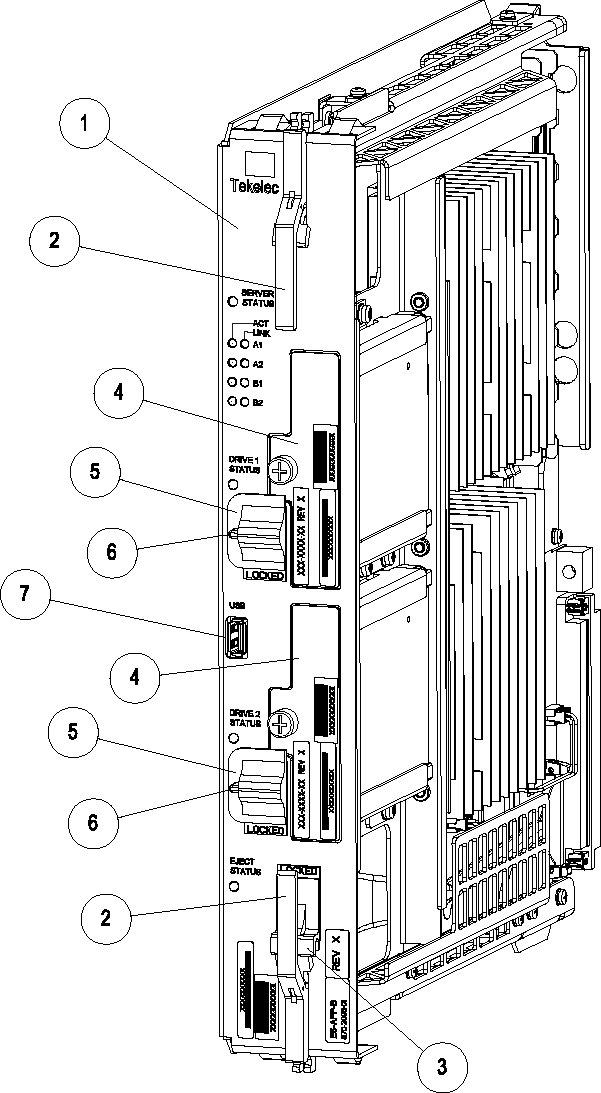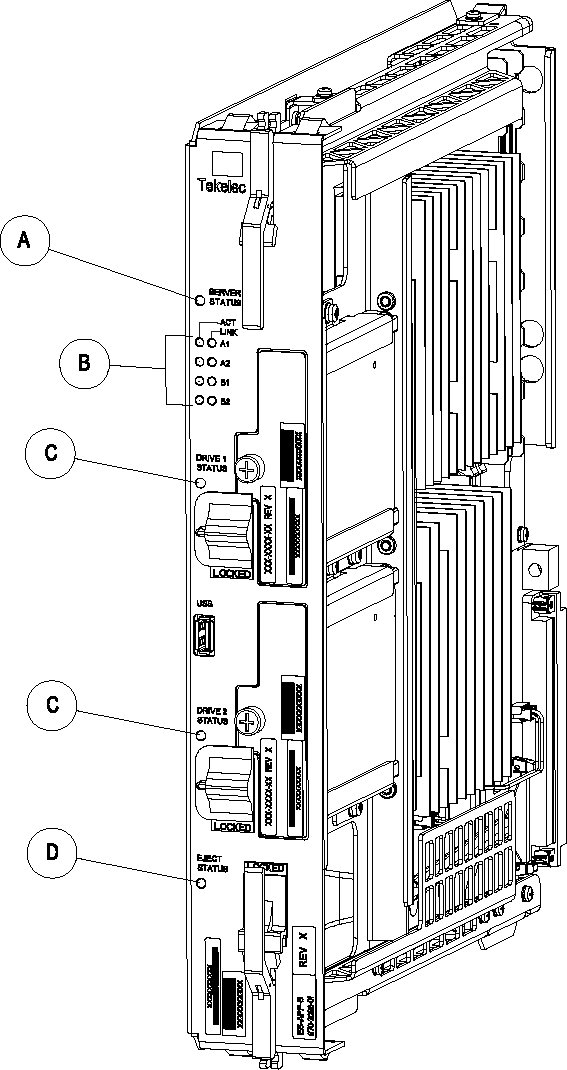3 E5-APP-B Card Overview
This chapter presents an overview of the E5-APP-B card package, components, and adapter interfaces.
Note:
For the complete list of cards supported by EAGLE Release 47.0, see Hardware Reference Guide.3.1 Introduction
E5-APP-B card packages are designed to be integrated with features that run on a Signal Transfer Point (STP). E5-APP-B cards for these applications run in a Direct Current (DC) environment and are delivered as a pair to be installed in an EAGLE using heavy duty frames, along with breaker panels and Ethernet communication equipment.
Note:
The E5-APP-B Card is not IMT Bus capable.For more information about EAGLE shelves, see the EAGLE Hardware Guide.
This chapter provides an overview of E5-APP-B cards and highlights E5-APP-B card features, components, and adapter interfaces.
3.2 E5-APP-B Card
An E5-APP-B card comes with two removable drive modules when first ordered. A complete shipping package for applications includes:
-
Two E5-APP-B standard EAGLE double-wide cards, identified as A and B. Each E5-APP-B card is loaded at the factory with platform software and application software.
-
Two removable drive modules for each separate card. For more information about these components, refer to the documentation delivered with the product.
Note:
The -01 card is smaller (300GB) than the -02 card, which has a 480G drive. The only difference between the two card types is SSD capacity.Figure 3-1 shows an example E5-APP-B card in a shelf(1).
Figure 3-1 E5-APP-B Card In Shelf

Compatible Applications and Card Types
The following table shows which applications can run on the both the -01 and -02 or only the -02 card:
Table 3-1 Application and Card Type Compatibility
| Application | Card Type(s) |
|---|---|
| ELAP | -01 or -02 |
| EPAP* | -01 or -02 |
| LSMS | -02 |
| PIC/IMF | -02 |
* Beginning with Release 16.1, the 240M DN + 240M IMSI + 48M IMEI feature requires the -02 card.
3.3 E5-APP-B Card Features
A single E5-APP-B card is a general-purpose application server (AS) that offers high transaction rates with low latency. It supports a variety of application solutions for the wireless and wireline telecommunications infrastructure to provide the building blocks for next-generation signaling systems.
The E5-APP-B card is a scalable computing platform constructed with state-of-the-art components packaged on a double-wide card designed to fit into two slots of an EAGLE shelf. Each E5-APP-B card has two removable drive modules. E5-APP-B cards are installed in pairs for redundancy and high availability.
Figure 3-2 shows a single E5-APP-B card. This view shows where hardware components, especially Field Replaceable Units (FRUs), are located.
Figure 3-2 E5-APP-B Card

The following are Field Replaceable Units:
- E5-APP-B card (1)
- Drive Module (4)
For more information about FRUs, see the corresponding Alarms and Maintenance guide included in this release.
- Injector/Ejector (2)
- Ejector Switch (3)
- Drive module locking switch (5)
- Switch lock release (6)
- USB Port (7) - Used for software upgrades
E5-APP-B Card Status Indicators
Figure 3-3 E5-APP-B Card Indicators

The following light-emitting diode (LED) status indicators (see Figure 3-3) can be found on the E5-APP-B card:
- One Server Status indicator (A)
- Four E-Net link and Active LED status indicators (B)
- Two drive module status indicators (C)
- One Card Eject status indicator (D)
For more information about the diagnostics that manage these alarm and status indicators, see E5-APP-B Card Diagnostics.
E5-APP-B Card Installation
A single E5-APP-B card is installed in two adjacent EAGLE shelf slots. To install two E5-APP-B cards for redundancy (the recommended configuration), the EAGLE must have room to install two double-width cards.
3.4 E5-APP-B Card Components
The E5-APP-B card consists of the following standard hardware components:
-
Dual Core 2.66GHz 64-bit processor
- Active/Trial BIOS architecture
-
1333 megahertz (MHz) processor front side bus speed
-
8 GB DDR2 DRAM
-
Light Emitting Diode (LED) status display
-
Hardware monitors that read and report:
-
Supply and core voltages
-
Fan alarm inputs
-
Ambient and processor temperatures
-
-
Two drive modules (Field-replaceable Units (FRUs))
3.5 E5-APP-B Card Interfaces
The E5-APP-B card includes interfaces for accommodating expansion, control and configuration, network connectivity, and peripheral support.
Table 3-2shows the basic interfaces on the E5-APP-B card.
Table 3-2 E5-APP-B Card Interfaces
| Interface | Description |
|---|---|
|
Four Serial interfaces |
Standard RS-232D serial interfaces are usually used for connecting to other equipment. The Serial interfaces are accessed via backplane adapters. |
|
One USB port - For software upgrades |
One Universal Serial Bus (USB) port to support direct connectivity to peripherals. The USB port is accessible from the E5-APP-B card front panel. |
|
Fan Alarm |
Fan Alarms are received through the application GUI. See E5-APP-B Fan Alarms for more information. |
|
Four 1 Gigabit (Gb) Ethernet ports |
Ethernet ports to communicate with other nodes on the network. The Ethernet ports are accessed via backplane adapters. |
3.6 Electrical Features
The E5-APP-B card has the following standard electrical features:
-
Operates from -40 VDC to -56.7 VDC power input, according to Network Equipment Building System (NEBS) requirements in accordance with typical telecommunications applications
-
Includes short-circuit protections and safety precautions in accordance with common standards
3.7 Mechanical Design and Maintenance Features
The E5-APP-B card mechanical design meets all applicable NEBS requirements and is designed to protect all active components. The design has efficient component cooling using low-impedance air paths, and its compact size allows multiple units to be configured in a shelf with zero clearance.
The E5-APP-B card has been designed for easy maintenance. The following components are Field-replaceable Units (FRUs):
- The E5-APP-B card
- The drive module assembly
Device: /dev/sdX [SAT], SMART Failure: FAILURE PREDICTION THRESHOLD
EXCEEDED: ascq=0xNN"/dev/sdX" and replace it as soon as possible.
The disk drives have high mean time between failures (MTBF) and can be easily replaced.
Note:
When removing or replacing FRUs, use the procedures in the corresponding Alarms and Maintenance Guide for this release, if available. Use the inject/eject switch on the E5-APP-B card before switching OFF all circuit breakers or power distribution units supplying redundant power. For more information about troubleshooting systems and performing soft shutdowns, see the appropriate maintenance guide for the application.3.8 E5-APP-B Card Diagnostics
All components that comprise the E5-APP-B card platform are designed for testability to ensure that operational status can be accurately determined and that appropriate levels of fault detection and isolation are possible with a minimum of effort.
The following levels of diagnostics are provided:
-
Online diagnostics actively monitor the health of a running E5-APP-B card platform. When online diagnostics encounter a problem, an alarm is raised and front fascia light-emitting diodes (LEDs) are illuminated to indicate the status of certain components of the E5-APP-B card. For more information about the E5-APP-B card LEDs, see Table 3-3. Online diagnostics can be run while maintaining in-service operation of node.
Diagnostics enable troubleshooting of installed systems by verifying operational capability of Field Replaceable Units (FRU) and operational status of peripheral system components (such as cables and connectors) through automated testing initiated by FRU components. Examples are loop-back and link tests.
Table 3-3 E5-APP-B LED Table
| LED Name | HW/SW Controlled | Description |
|---|---|---|
| Server Status | SW |
Solid Red - Server is halted Flashing Red - Server is booting Solid Amber - TKLC configuration beginning Solid Green - TPD loaded/operational state Flashing Green - Server is shutting down |
| Drive 1 Status | SW/HW |
HW: Flashing Green - Drive activity SW: Flashing Red - Impending drive removal SW: Steady Red - Drive ready for removal |
| Drive 2 Status | SW/HW |
HW: Flashing Green - Drive activity SW: Flashing Red - Impending drive removal SW: Steady red - Drive ready for removal |
| Eject Status | SW |
Red - Card ready for extraction Flashing Red - Card preparing for extraction Off - Card is not ready for extraction |
| Act LED A1 | HW | Flashing Green - Link Activity |
| Act LED A2 | HW | Flashing Green - Link Activity |
| Act LED B1 | HW | Flashing Green - Link Activity |
| Act LED B2 | HW | Flashing Green - Link Activity |
| Link LED A1 | HW |
Green - 10/100 Link Speed Amber - 1000 Link Speed |
| Link LED A2 | HW |
Green - 10/100 Link Speed Amber - 1000 Link Speed |
| Link LED B1 | HW |
Green - 10/100 Link Speed Amber - 1000 Link Speed |
| Link LED B2 | HW |
Green - 10/100 Link Speed Amber - 1000 Link Speed |